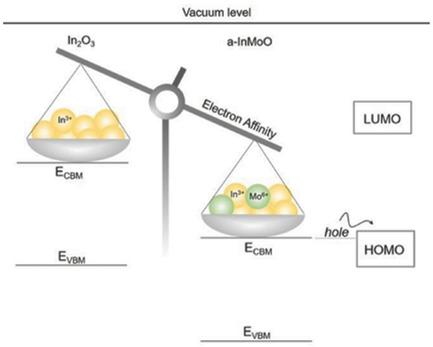当前位置:
X-MOL 学术
›
Adv. Mater. Interfaces
›
论文详情
Our official English website, www.x-mol.net, welcomes your
feedback! (Note: you will need to create a separate account there.)
Electron Affinity Control of Amorphous Oxide Semiconductors and Its Applicability to Organic Electronics
Advanced Materials Interfaces ( IF 4.3 ) Pub Date : 2018-10-04 , DOI: 10.1002/admi.201801307 Junghwan Kim 1 , Koji Yamamoto 2 , Soshi Iimura 2 , Shigenori Ueda 3, 4 , Hideo Hosono 1, 2
Advanced Materials Interfaces ( IF 4.3 ) Pub Date : 2018-10-04 , DOI: 10.1002/admi.201801307 Junghwan Kim 1 , Koji Yamamoto 2 , Soshi Iimura 2 , Shigenori Ueda 3, 4 , Hideo Hosono 1, 2
Affiliation

|
Energy level matching is a key factor for realizing efficient optoelectronics, such as organic light‐emitting diodes (OLEDs). Transition metal oxides (TMOs) are widely used as hole‐injection layers (HILs) because of their large electron affinities, corresponding to conduction band minimum levels (ECBM). However, the poor electrical properties and chemical instabilities of TMOs restrict device performance and fabrication processes. Conversely, amorphous oxide semiconductors (AOSs) exhibit superior electrical properties and chemical stability but cannot be applied to HILs because of their small electron affinities. In this study, a novel method is proposed to tune the electron affinity of conventional AOSs and an example material design of AOSs for HILs. The electron affinity deepening phenomenon that is attributable to the higher oxidation states of transition metal cations achieves a very deep ECBM of 5.7 eV for the proposed amorphous In–Mo–O (a‐IMO). Furthermore, an a‐IMO exhibits a high mobility of ≈1 cm2 V−1 s−1 and high chemical stability against various solvents. As a result, it is demonstrated that a very thick a‐IMO layer is applicable to OLEDs as an HIL with no operating‐voltage increase. This study provides a new approach for efficient organic optoelectronics by tuning the electron affinity of AOSs.
中文翻译:

非晶氧化物半导体的电子亲和力控制及其对有机电子的适用性
能级匹配是实现高效光电器件(例如有机发光二极管(OLED))的关键因素。过渡金属氧化物(TMO)由于其大的电子亲和力而被广泛用作空穴注入层(HIL),对应于导带最小能级(E CBM)。但是,TMO的不良电性能和化学不稳定性限制了器件性能和制造工艺。相反,非晶氧化物半导体(AOS)表现出优异的电性能和化学稳定性,但由于其电子亲和力小,因此无法应用于HIL。在这项研究中,提出了一种新颖的方法来调节常规AOS的电子亲和力,并提出了用于HIL的AOS的示例材料设计。对于拟定的In-Mo-O(a-IMO)非晶态,由于过渡金属阳离子的较高氧化态而引起的电子亲和力加深现象实现了非常深的E CBM 5.7 eV。此外,a-IMO具有约1 cm 2 V -1 s -1的高迁移率以及对各种溶剂的高化学稳定性。结果表明,非常厚的a-IMO层适用于OLED作为HIL,而不会增加工作电压。这项研究通过调节AOS的电子亲和力,为有效的有机光电提供了一种新方法。
更新日期:2018-10-04
中文翻译:

非晶氧化物半导体的电子亲和力控制及其对有机电子的适用性
能级匹配是实现高效光电器件(例如有机发光二极管(OLED))的关键因素。过渡金属氧化物(TMO)由于其大的电子亲和力而被广泛用作空穴注入层(HIL),对应于导带最小能级(E CBM)。但是,TMO的不良电性能和化学不稳定性限制了器件性能和制造工艺。相反,非晶氧化物半导体(AOS)表现出优异的电性能和化学稳定性,但由于其电子亲和力小,因此无法应用于HIL。在这项研究中,提出了一种新颖的方法来调节常规AOS的电子亲和力,并提出了用于HIL的AOS的示例材料设计。对于拟定的In-Mo-O(a-IMO)非晶态,由于过渡金属阳离子的较高氧化态而引起的电子亲和力加深现象实现了非常深的E CBM 5.7 eV。此外,a-IMO具有约1 cm 2 V -1 s -1的高迁移率以及对各种溶剂的高化学稳定性。结果表明,非常厚的a-IMO层适用于OLED作为HIL,而不会增加工作电压。这项研究通过调节AOS的电子亲和力,为有效的有机光电提供了一种新方法。











































 京公网安备 11010802027423号
京公网安备 11010802027423号